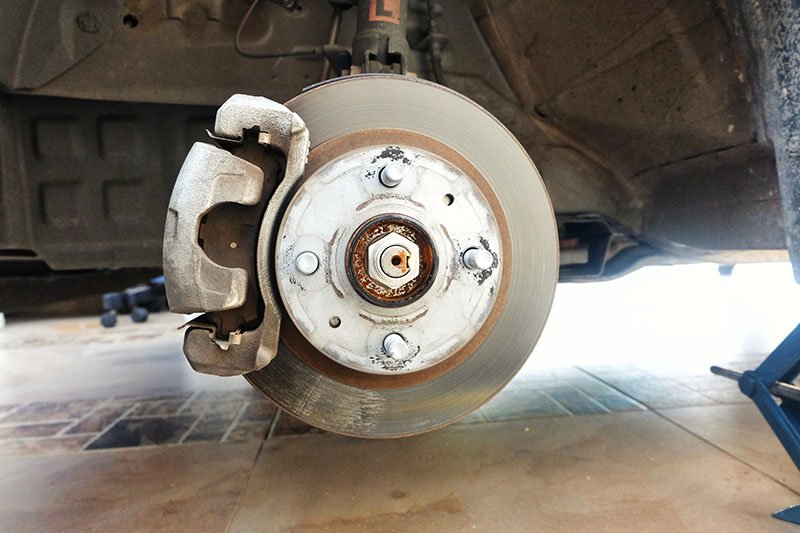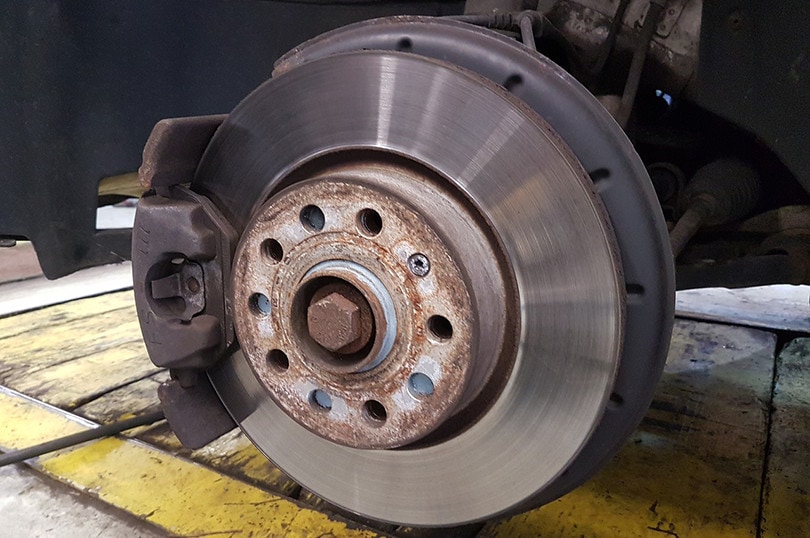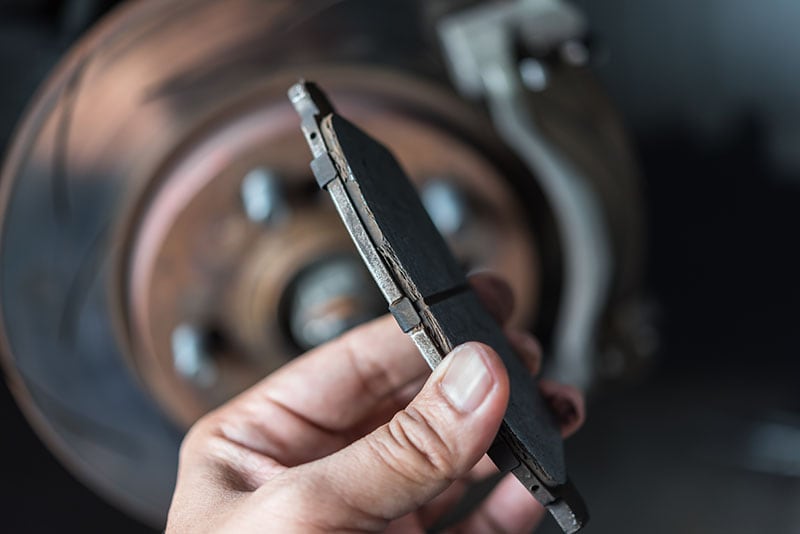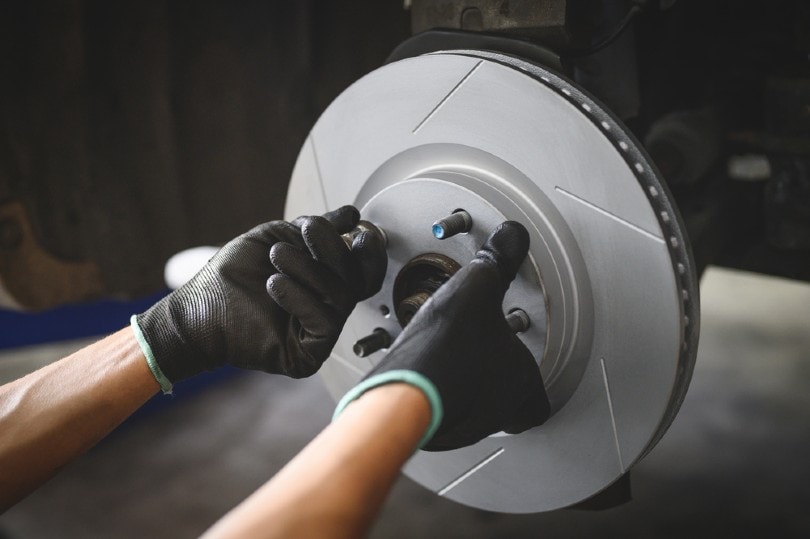How Do Disc Brakes Work? Pros, Cons, & Types
-
Pete Ortiz
- Last updated:

A disc brake is a type of brake used on some automotive vehicles. It consists of a brake caliper, a rotor, and brake pads. The rotor rotates with the wheel, and when the brakes are applied, calipers that have brake pads attached to them are squeezed against the rotor. This creates friction which slows the rotation of the wheels before eventually bringing them to a complete standstill.
The process does generate heat, but the whole disc brake system is usually exposed so that the heat dissipates and does not cause damage or interfere with the braking system. Disc brakes are most often used for the front wheels of cars, while drum brakes are used for the rear, although this does differ in some models.
How Does It Work?
- Rotor – The rotor, which is the disc element of the disc brake, is attached to the inside of the wheel. It rotates at the same speed as the wheel because it is firmly fixed.
- Caliper – The brake calipers have brake pads attached to them, and when the brake is applied, the caliper is effectively squeezed and pushed toward the wheel.
- Brake pads – The brake pads, which are attached to the caliper, are the section of the brakes that come into contact with the wheel. They are usually made from a material like rubber, which does not cause damage to the wheel but can still apply friction in such a way as to slow the wheel’s rotational force.
What Are the Different Types of Disc Brakes?

There are different types of disc brakes, usually defined by the shape or design of the disc or caliper.
- Flat Brake Disc – The simplest brake disc is the flat disc. It is usually made of a material like iron and is perfectly flat. This type of system is commonly used on smaller, lighter cars. The lower weight of the car means that it doesn’t need complex discs to slow and stop the vehicle, and the simple design makes the flat brake disc inexpensive and easy to manufacture.
- Vented Brake Disc – Although disc brake systems are exposed to the atmosphere and heat is therefore dissipated naturally, heavier vehicles produce more heat when the brakes are applied. This can cause braking to suffer under heavy load. Gaps between two layers of disc allow the heat generated to be vented more effectively away from the system, therefore preventing heat damage.
- Drilled Brake Disc – Where even greater heat dissipation is required, vented discs might also have holes drilled right through the disc. This not only allows heat to escape via the venting but also allows waste material like rubber from the brake pads and dirt to escape.
- Slotted Brake Disc – Grooves added to the disc also work to remove heat, dirt, and grease. These grooves are angled to provide the best possible results, but the rubbing of the grooves against the pads can make this type of brake noisier.
- Combination Brake Disc – Combination brake discs use slots and drill holes to provide excellent levels of heat and dirt removal. Fewer slots mean less noise, while fewer drill holes enable the metal of the disc itself to retain its heat-resistant properties.
- Dimpled Brake Disc – Dimpled discs are similar to drilled discs except the holes do not go all the way through; they effectively create dimples on the surface. This type of brake is not as effective at removing waste materials but is still very effective at dissipating heat from the brakes. But because the holes do not go all the way through the disc, the metal retains its strength and other beneficial qualities.
- Waved Brake Disc – Waved brake discs have waved edges. This design reduces weight and waves also disrupt airflow, therefore helping to remove heat from the system.
Where Is It Used?
Disc brakes have become fairly commonplace in cars and on motorbikes and bikes. They are also used on some other types of machinery. Most often, disc brakes are used for the front wheels of vehicles because they are resistant to water fade.
As the disc spins, it expels any water, typically picked up from wet roads. Water fade can cause brakes to lose efficiency, which means that the wheels will not slow as quickly as they do when they are dry. Disc brakes prevent this. Despite using disc brakes on the front wheels, many vehicles still use drum brakes for the rear wheels.

Advantages of Disc Brakes
Typically, disc brakes are used in favor of drum brakes, and they offer the following benefits over this type of brake system:
- Fewer Moving Parts – Drum brakes can have between nine and 12 moving parts, compared to the one moving part of the disc brake. Fewer moving parts mean less chance for error, lower maintenance requirements, and greater long-term braking performance.
- Better heat dissipation – Disc brakes are open to the atmosphere, which allows most, if not all, of the heat that is developed during the braking process, to dissipate.
- Pads Are Easily Accessible – Brake pads need changing and they need regular inspection to ensure that they are still in good condition. The open system of a disc brake makes it easy to check the pads and change them when needed.
- Better Performance in Wet, Dirt, and When Rusty – Disc brakes are wet-resistant, and some of the disc brake designs are also very effective at dispelling dirt and grease. Even when rust starts to develop, they will still brake effectively.
Disadvantages of Disc Brakes
Despite having several advantages over alternative systems, disc brakes do have some disadvantages that mean they are not used in all cases.
- Expensive – Disc brakes are more advanced than drum brakes, which means that they also have a higher cost. This is the biggest disadvantage and the reason that this type of brake is not used on all wheels of all cars and vehicles.
- Heavier – The components of a disc brake system make it heavier than a drum brake, which can have a big impact, especially on smaller and lighter vehicles.
- Can Warp – The rotor, or disc, is squeezed and put under pressure during braking, and this can lead to it becoming warped, so some maintenance is required.
 Frequently Asked Questions (FAQs)
Frequently Asked Questions (FAQs)
How long do brake discs last?
It really depends on the brakes and the vehicle that they are used on. On cars, brake discs will usually last around 50,000 miles, but it is possible to get up to 80,000 out of some brakes. Having a regular service means that you will know when your discs need replacing or repairing.

Why do brake discs rust?
Brake discs are typically made of cast iron. Cast iron is a ferrous material that will rust when exposed to moisture. Moisture can come up from the road, but it is also present in humid air, so brake discs on cars in humid climates will be more prone to rusting.
How do you clean brake discs?
Some brake discs do an effective job of getting rid of dirt, dust, and grease themselves, but they can still benefit from the occasional cleaning. Access the disc brake and wipe it down with a rag and brake cleaning fluid. You can use the same rag and fluid to clean any rusty areas.
Conclusion
The brakes on cars, bicycles, motorbikes and other vehicles obviously play a very important role. The disc brake is generally considered to offer better braking under a greater range of conditions than the drum brake, but it is more expensive and weighs more.
Disc brakes are most often used on the front wheels of cars with drum brakes used on the rear wheels. They are effective at dissipating heat as well as dirt and grease while also allowing for hard braking in a range of weather conditions.
Featured Image Credit: Najmi Arif, Shutterstock
Contents


 Frequently Asked Questions (FAQs)
Frequently Asked Questions (FAQs)
